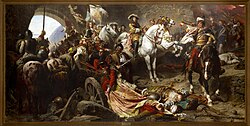Pest-Pilis-Solt-Kiskun County
Counties in the Kingdom of HungaryStates and territories disestablished in 1950States and territories established in 1876

Pest-Pilis-Solt-Kiskun is the name of an administrative county (comitatus) of the Kingdom of Hungary. Its territory is now in central Hungary, comprising roughly the territory of the present Hungarian county Pest and the northern part of present Bács-Kiskun county. The capital of the county was Budapest.
Excerpt from the Wikipedia article Pest-Pilis-Solt-Kiskun County (License: CC BY-SA 3.0, Authors, Images).Pest-Pilis-Solt-Kiskun County
Kemal Atatürk sétaút, Budapest Tabán
Geographical coordinates (GPS) Address Nearby Places Show on map
Geographical coordinates (GPS)
| Latitude | Longitude |
|---|---|
| N 47.5 ° | E 19.033333333333 ° |
Address
Vár
Kemal Atatürk sétaút
1013 Budapest, Tabán
Hungary
Open on Google Maps










